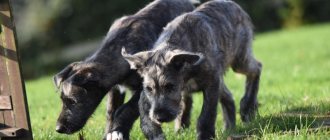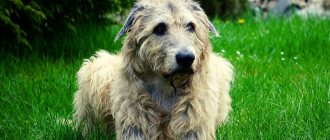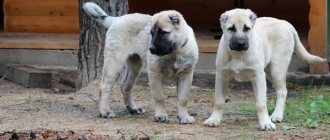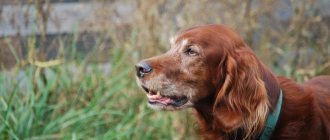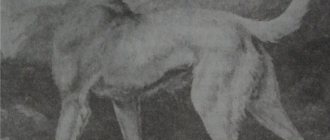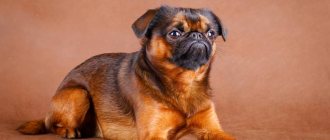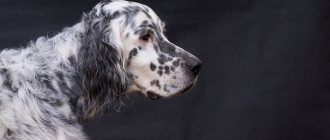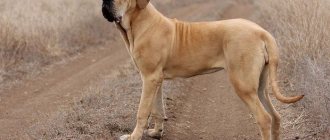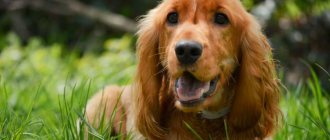Breed characteristics and character
The Irish Wolfhound dog is famous for its gigantic size. If she stands on her hind legs, she will be taller than the average person. In Russia, you rarely see these animals on the street, especially within the city. They are mainly kept outside the city as watchdogs. But in ancient times they had slightly different functions.
Irish Wolfhound age 3.5 years
The roots of the oldest breed are directed to insular England. Even the ancient Celts used the wolfhound as a gun dog, hunting large game such as wild boars and elk, as well as wolves, which is where the name of the breed came from.
The history of the origin of the Irishman is shrouded in many secrets, the most beautiful of which says that the ancestor of the animal was a princess. In Ireland, this breed is considered national.
In the Middle Ages, a ban was introduced on the export of dogs outside the state. Around the same time, a guard function was added to the hunting function. The dog began to guard the palaces and houses of the nobility, and was an active participant in many ceremonies at the royal court.
It is believed that the Irish Wolfhound has remarkable intelligence, has royal blood and inspires fear with its stern appearance. A surge of interest in the breed occurred in the second half of the century before last. An English army officer began breeding, and the breed officially began to be taken into account by dog handlers in 1879. A little later, a breed club appeared.
Irish Wolfhound on a walk in summer
Currently, dogs have lost their gift for hunting, and it’s a stretch to call them guards. The only thing that will scare off a thief is a menacing appearance. Wolfhounds have truly royal self-control and calmness. They are balanced and not at all hysterical.
But this large dog will not survive in an enclosure, because it suffers greatly from loneliness. A description of the Irish Wolfhound cannot do without such a quality as sensitivity. The animal is able to capture any negative emotions of the owner and senses when there is a tense atmosphere in the family.
He is very worried about this. The carrot and stick method will not work with a dog. You just need to communicate with him kindly. Otherwise, the wolfhound will quietly and meekly look into the eyes of the one who shouted and silently retire with a mournful look to the farthest corner. There he will comprehend what is happening and not understand what he did wrong.
The dog has a sociable disposition and will accept other pets, offering them his friendship. He will never offend even a tiny kitten, like other kids. The wolfhound will never touch the weak.
The animal is highly trainable; it can be taught the simplest standard commands in a couple of months. If a professional trainer works with a dog, teaching him the basics of hunting or guarding, then ancient instincts can awaken in him.
Irish Wolfhound is waiting for an owner
This will make the dog dangerous to others, including the owner. But the wolfhound is rarely trained as a hunter. He is more popular as a companion, or rather, a devoted companion.
Historical reference
The name of the breed clearly reflects the history of its formation - initially these dogs were used as protectors and for hunting wolves.
The Celts introduced wolfhounds to Britain 300 BC. – the breed is more than 2000 years old.
The ancestors of wolfhounds were used in Ancient Rome to bait animals in the circus.
For their prudence, courage and kindness, combined in one dog, they have become symbols and characters of many legends.
A pair of Irish wolfhounds was considered a valuable gift in the royal houses of Europe and Scandinavia from the Middle Ages to the 17th century. They were sent to England, Spain, France, Sweden, Denmark, Persia, India and Poland.
At that time, they were actively used for hunting deer, elk, and bears. Wolfhounds were also used in warfare to scare away enemies.
In the 18th century, all wolves were exterminated, and the main purpose of wolfhounds lost its power, so the breed was on the verge of extinction, but found application in other areas.
In 1955, the FCI adopted an international breed standard, the basis of which has been preserved in new editions.
The Irish consider it a national symbol that reflects their character. In England, they serve to maintain order during public speeches, parades and other significant events.
In our country, the breed is present in limited quantities, although in the world it is again gaining popularity, as in the Middle Ages.
Breed standard
The Irish Wolfhound looks impressive in the photo, let alone pictures from life. The breed standard implies that the dog carries its head proudly, and its shape is slightly elongated. The forehead is wide, and the dividing furrow is not very clear. The muzzle is wide and level with strong chewing muscles. The dog has a deep mouth, and the transition from forehead to muzzle is not too noticeable.
The mouth is equipped with even white teeth with a scissor bite. However, a direct bite is also possible. The nose is not too large and has large nostrils. The dog looks at the world with small round dark brown eyes with a smart expression. The ears are raised to a third, with rounded tips pointing forward.
The dog's body visually resembles a rectangle, but not too elongated. The neck is long, wide and muscular, which gives the dog a perfect and noble appearance. Weakly defined withers merge into a long back. The chest is deep, not very wide, but developed. The groins are tight, but not dry. The wolfhound has long, thick and strong paws set parallel.
The pads are tucked and collected and the nails are strong. The tail is of medium thickness and slightly curved at the end. The fur feels like wire to the touch, it is hard, but softer on the belly. Various color options are acceptable, but pure white is rare. Much more popular are beige, fawn and gray tones, as well as gray-blue colors.
There are red and yellow wolfhounds, as well as sand-brick and brindle. The dog is equipped with a dense undercoat that repels water and maintains optimal body temperature, protecting the dog from the wind and scorching sun.
Exterior description
FCI standard No. 160 dated March 13, 2001 “Irish wolfhound”. Group 10 "Greyhounds". Section 2 “Wire-haired greyhounds”.
Height at withers:
- for males - at least 79 cm (with a weight of 54.5 kg);
- in females - at least 71 cm (with a weight of 40.5 kg).
Wolfhounds are agile, muscular, strong, dominant, holding their heads up, showing their superiority.
Tall growth is a distinctive feature of the Irish , which is also recorded in the Guinness Book of Records.
Photo of an Irish Wolfhound with a man
The high, long head complements the clean proportions of the animal's body, and the scissor or straight bite hides a row of large, sharp teeth.
Wolfhounds have dark, thoughtful eyes, attentive to what is happening. The nose has a sensitive sense of smell and can only be black.
The neck is quite long, strong, a wide sternum with developed ribs, and a toned stomach have helped since ancient times during hunting, giving strength and endurance.
massive paws do not aggravate the silhouette, but impart a sporty gait and smoothness. Fingers with very strong claws are curved and collected.
Irish Wolfhounds have a profuse coat of hair; coarse, wiry hair covers the entire body of the animal.
- grey;
- black;
- white;
- brindle;
- yellowish brown;
- red;
- any other color found in a Deerhound (as indicated in the breed standard).
By the way, the Irish Wolfhound and the Deerhound are very similar: both breeds belong to the category of “wire-haired greyhounds” and many people confuse them. But there are also significant differences. Thus, the Deerhound has a leaner build and is slightly shorter in stature. Nowadays it is not difficult to distinguish them - the Deerhound is slimmer and lighter.
The apparent similarity is dispelled by the difference in the characters and behavior of the animals: the Deerhound is an excellent greyhound, the owner of a furious character, with a pronounced hunter's instinct, the Wolfhound is calmer and not dangerous for small animals.
Care and maintenance
, the Irish Wolfhound needs careful care. The great kosmach leaves his fur marks everywhere, and during the molting period his presence in the house is especially noticeable. Therefore, brushes and combs should be used daily, or even twice a day.
But there is no need to be frequent with bath procedures. Otherwise, the protective lubricant that repels dirt will be washed away. In slush and rain, the dog should wipe its paws and belly, and bathe three to four times a year.
Despite its gigantic size, the animal, as the breeders assure, tolerates the conditions of a city apartment well. The dog behaves extremely delicately, so a pogrom will not happen.
It is enough to spend the required 20-30 minutes on a walk. The dog does not particularly respect physical activity, preferring to walk with a royal gait that does not tolerate fuss. However, if the dog lives in a private house, and there is a piece of land where he can run, then you should not interfere with him - let him feel freedom.
Irish Wolfhound nurseries closest to Voronezh
Breeder Marina Fedotova
Russia, Lipetsk E-mail, Phones: +7 (906)-682-96-93, +7 (900)-598-56-17
Kennel "Tsarskaya Prihot"
Russia, Moscow Owner: Natalya Beresneva Website: www.irishwolfdog.ru E-mail Skype: egoza_n Phones,
Nursery “From the Magic Forest”
Russia, Moscow Website: https://www.irishwolfhound.ru Phones,
Nursery "Solar Wind"
Russia, Moscow Owner: Tatyana Laptina E-mail Phones, +7 (495) 662-07-24
Nutrition
The Irish Wolfhound is considered a specific breed. It has a heavy and powerful skeleton, grows quickly, and has well-developed ligaments. Food must be selected in accordance with these characteristics.
Perhaps there will be fewer problems with this particular breed if the owner buys ready-made food for the animal. Otherwise, when cooking naturally, the portions will be such that an XXXL size bowl will be required.
But even if this did not stop the ardor of the caring owner, it is worth knowing that the dog has a capricious gastrointestinal system. This means you should limit your consumption of legumes and fermented milk products.
If the choice falls on industrially produced dry food, then it is important that it is of high quality. As a rule, such products already contain the necessary additives in the form of vitamins and minerals.
This means there is no point in purchasing anything additional. Irish Wolfhound puppies should receive dry food in a soaked form until the baby teeth are replaced by molars.
The frequency of feedings is usually indicated on the package and rarely exceeds 5-6 times a day. Adult dogs receive larger doses, but less frequently, up to twice a day. It is important to maintain a balance in nutrition throughout the dog’s life, not only in puppyhood and prime, but also in old age.
Otherwise, the dog will greatly sag in external characteristics, and physically weaken quickly. It is also important to remind about the drinking regime - a bowl of clean water should never be empty, and the water should be renewed once a day.
The character of the four-legged Irish
Irish Wolfhounds are not overly aggressive. They are affectionate, calm, obedient, kind to people and animals. Phlegmatic and melancholic people are more common among these dogs than among other breeds.
Endurance, speed, hard work and intelligence - these are the main traits of pets that help them in everyday life. Wolfhounds are known to be excellent runners. The sin is that they like to chase small birds and cats. Since the dogs are very large, they need to be raised with special care.
Possible diseases
The Irish Wolfhound breed is prone to various types of diseases. These include gastrointestinal diseases, joint problems, thyroid diseases, and various types of dermatitis. Thus, ailments of the gastrointestinal tract include bloating.
Therefore, the dog should be sharply limited in the consumption of legumes and other foods that can cause fermentation. Sour milk is recommended no more than once a week. Like any other large dog, wolfhounds suffer from diseases of the musculoskeletal system. The most common problem is hip dysplasia.
In addition, dislocations of the kneecaps and various types of osteochondrosis are possible. Endocrine diseases include hypothyroidism - insufficient functioning of the thyroid gland. Among eye diseases, cataracts are distinguished.
The dog has a lot of skin ailments - pyoderma, Malassezial dermatitis, and osteosarcoma. All of them require specialist advice. For any skin or coat problems that seem minor at first glance, you should visit a veterinarian.
Character, abilities, skills
Despite their tall stature, these dogs are excellent hunters, easy on their feet, quick to react and responsive to their owners.
Lambs are at home, lions are in battle.
It is precisely this laconic and imaginative characteristic that the official standard gives to the breed .
Irish Wolfhounds have lived side by side with people for a long time, so they are characterized by friendliness, kindness, pliability, and patience with loved ones. However, they often show wariness towards strangers, and the offender of this dog or its owner will not find it enough , in a fight they are ready to fight to the death.
The Irish Wolfhound needs professional training that can curb and consolidate the best qualities of the breed in the dog.
Excellent hunters, real warriors, in our time they have turned into show dogs, agility athletes (without much success) or watchdogs, faithfully guarding the sleep of their owners.
